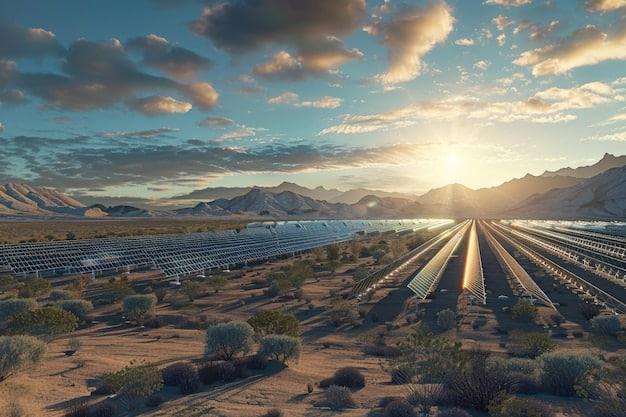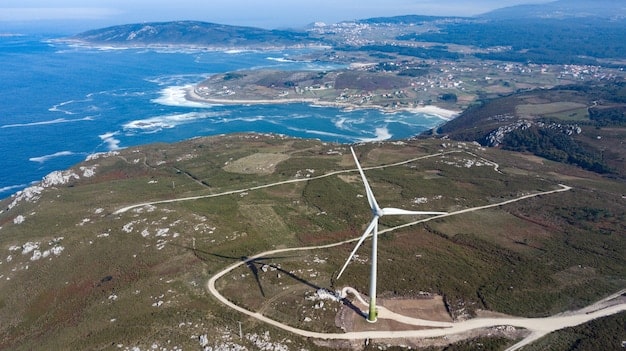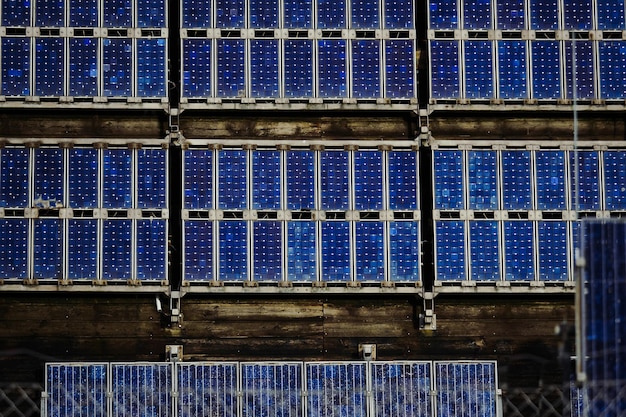The Future of US Energy Policy: Renewable Energy Initiatives in Focus

The Future of US Energy Policy: A Look at Renewable Energy Initiatives reveals a shift toward sustainable energy sources. Key strategies involve federal incentives, technological innovation, and infrastructure development to promote a cleaner energy sector.
The energy landscape in the United States is undergoing a significant transformation, driven by growing concerns about climate change, energy security, and economic opportunities. The Future of US Energy Policy: A Look at Renewable Energy Initiatives is critical for understanding this shift. As the nation strives to reduce its carbon footprint and transition to a more sustainable energy system, renewable energy sources are taking center stage.
What are the key policy initiatives shaping this future? How can the US effectively harness its vast renewable resources? Let’s dive in to explore.
Understanding the Current US Energy Policy Landscape
To fully grasp the future direction, let’s examine the present. The current US energy policy landscape is a complex mix of federal and state initiatives, incentives, and regulations.
Federal Energy Policies
Federal policies play a crucial role in shaping the energy sector. These include tax credits, grants, and loan programs aimed at promoting renewable energy deployment.
- Investment Tax Credit (ITC): Provides tax credits for investments in solar energy projects.
- Production Tax Credit (PTC): Offers tax credits for electricity generated from renewable sources like wind and biomass.
- Loan Programs Office: Supports innovative clean energy projects through loans and loan guarantees.
These policies provide financial incentives for developers and investors, encouraging the growth of renewable energy infrastructure. Furthermore, regulatory measures such as the Clean Power Plan (though subject to legal challenges) aim to reduce carbon emissions from power plants, driving demand for cleaner energy sources. Understanding the current policies helps shape any discussion on the future of US energy policy.

The effects of these policies can be seen in the increasing deployment of solar, wind, and other renewable energy technologies across the country. States with supportive policies and ambitious renewable energy targets have witnessed significant growth in their renewable energy sectors. The continued federal and state action is crucial for promoting a sustainable and cleaner energy future.
The Role of Renewable Energy Initiatives in the Future of US Energy Policy
Renewable energy initiatives are not just add-ons; they are central to The Future of US Energy Policy: A Look at Renewable Energy Initiatives. These initiatives encompass a broad range of technologies and approaches aimed at harnessing sustainable energy sources.
Key Renewable Energy Technologies
Several renewable energy technologies are poised to play a significant role in the future of US energy. These include:
- Solar Power: Harnessing energy from the sun through photovoltaic (PV) panels.
- Wind Power: Converting wind energy into electricity using wind turbines.
- Hydropower: Generating electricity from the flow of water.
- Geothermal Energy: Tapping into the Earth’s internal heat for power generation.
Each of these renewable sources offers unique advantages and challenges. Solar and wind power have seen rapid growth in recent years, driven by technological advancements and decreasing costs. Hydropower, while a mature technology, faces environmental concerns and limited expansion potential. Geothermal energy holds promise but requires significant upfront investment and is geographically constrained. Diversifying our sources of renewable energy is important in The Future of US Energy Policy: A Look at Renewable Energy Initiatives.
As these technologies continue to advance and become more cost-competitive, they are expected to play an increasingly important role in meeting the nation’s energy needs and reducing its dependence on fossil fuels. Effective policy support, investment in research and development, and streamlined permitting processes are essential for unlocking the full potential of these renewable energy sources.
Technological Innovations Driving Renewable Energy
Technological innovations are at the heart of the renewable energy revolution. Advances in materials science, energy storage, and grid integration are making renewable energy more efficient, reliable, and affordable.
Advancements in Renewable Energy Technologies
Notable innovations shaping the renewable energy landscape include:
- High-Efficiency Solar Panels: Improved materials and designs that increase the amount of sunlight converted into electricity.
- Advanced Wind Turbine Designs: Larger and more efficient turbines that can capture more wind energy.
- Energy Storage Systems: Batteries and other storage technologies that store excess renewable energy for later use.

These innovations are not only improving the performance of renewable energy technologies but also addressing some of their key challenges, such as intermittency and grid integration. Energy storage systems, in particular, are playing a critical role in enabling a higher penetration of renewable energy into the grid by providing a buffer against fluctuations in supply and demand. Supporting innovation within The Future of US Energy Policy: A Look at Renewable Energy Initiatives will be a key component. As technologies continue to evolve, renewable energy will become even more competitive and integrated into the nation’s energy system.
Infrastructure Development for Renewable Energy Integration
Developing the necessary infrastructure is critical for integrating renewable energy sources into the grid and ensuring a reliable and resilient energy supply. This includes investments in transmission lines, smart grid technologies, and energy storage facilities.
The Need for Grid Modernization
Key aspects of infrastructure development include:
- Transmission Lines: Expanding and upgrading transmission infrastructure to transport renewable energy from remote generating sites to urban load centers.
- Smart Grid Technologies: Implementing advanced grid management systems that can monitor and control the flow of electricity in real-time.
- Energy Storage Facilities: Deploying large-scale energy storage systems to balance supply and demand and improve grid stability.
These investments are essential for ensuring that renewable energy can be reliably delivered to consumers and businesses. The current transmission infrastructure in many parts of the US is outdated and inadequate to handle the influx of renewable energy. Upgrading and expanding the grid is therefore a top priority for The Future of US Energy Policy: A Look at Renewable Energy Initiatives. Smart grid technologies, such as advanced sensors and control systems, can improve grid efficiency and resilience, while energy storage facilities can provide a buffer against fluctuations in renewable energy supply.
Effective infrastructure development requires careful planning, coordination among federal, state, and local authorities, and significant financial investment. Streamlined regulatory processes and public-private partnerships can help accelerate the deployment of renewable energy infrastructure and ensure that the nation’s energy system is prepared for a future powered by clean energy.
Policy Recommendations for Advancing Renewable Energy
To accelerate the transition to a renewable energy-based economy, several policy recommendations are worth considering. These include strengthening federal and state policies, promoting public-private partnerships, and investing in workforce development.
Strengthening Policy Frameworks
Specific recommendations include:
- Extending and Expanding Tax Credits: Providing long-term certainty for renewable energy developers and investors through extended and expanded tax credits.
- Establishing Renewable Energy Standards: Setting ambitious and enforceable renewable energy standards at the state level.
- Streamlining Permitting Processes: Reducing regulatory barriers and streamlining permitting processes for renewable energy projects.
A clear and consistent policy framework can create a stable investment climate for renewable energy and drive innovation and deployment. Tax credits, such as the ITC and PTC, have been instrumental in supporting the growth of solar and wind power. Renewable energy standards (RES) at the state level can create a guaranteed market for renewable energy. Streamlining permitting processes can reduce project costs and timelines associated with The Future of US Energy Policy: A Look at Renewable Energy Initiatives. Furthermore, policies that promote public-private partnerships can leverage private sector expertise and investment to accelerate the deployment of renewable energy infrastructure.
Investing in workforce development is also critical for ensuring that the US has the skilled workers needed to design, install, and maintain renewable energy systems. This includes training programs for technicians, engineers, and project managers. By implementing these policy recommendations, the US can accelerate its transition to a clean energy future and reap the economic and environmental benefits of renewable energy.
Challenges and Opportunities in the Transition to Renewable Energy
The transition to renewable energy presents both challenges and opportunities. Addressing these challenges and capitalizing on the opportunities will be critical for achieving a sustainable and prosperous energy future.
Addressing Key Challenges
Challenges include:
- Intermittency: Managing the variability of renewable energy sources, such as solar and wind.
- Grid Integration: Integrating large amounts of renewable energy into the existing grid.
- Land Use: Balancing the need for renewable energy development with other land uses, such as agriculture and conservation.
These challenges require innovative solutions and careful planning. Energy storage systems can help address the intermittency of solar and wind power by storing excess energy for later use. Smart grid technologies can improve grid stability and resilience by providing real-time monitoring and control. Land-use planning can help balance the need for renewable energy development with other land uses, ensuring that renewable energy projects are sited in appropriate locations. Despite the challenges, The Future of US Energy Policy: A Look at Renewable Energy Initiatives presents significant economic and environmental opportunities. These include job creation in the renewable energy sector, reduced greenhouse gas emissions, and improved energy security. By overcoming the challenges and capitalizing on the opportunities, the US can pave the way for a sustainable and prosperous energy future.
| Key Point | Brief Description |
|---|---|
| ☀️ Solar Power | Harnessing sunlight via photovoltaic panels for electricity. |
| 🌬️ Wind Energy | Converting wind power into electricity through turbines. |
| 🔋 Energy Storage | Using batteries to store excess renewable output. |
| ⚡ Grid Modernization | Upgrading infrastructure for renewable energy integration. |
Frequently Asked Questions
US energy policy aims to ensure energy security, promote economic growth, and protect the environment. It also focuses on diversifying energy sources and reducing dependence on foreign oil.
Renewable energy reduces carbon emissions, improves air quality, and enhances energy security. It also fosters innovation, drives economic growth, and creates jobs in the clean energy sector.
Government support includes tax credits, grants, and loan programs. Renewable energy standards (RES) also mandate a certain percentage of electricity from renewable sources. These facilitate The Future of US Energy Policy: A Look at Renewable Energy Initiatives.
Challenges include intermittency, grid integration, and high upfront costs. Overcoming these obstacles requires investments in energy storage, grid modernization, and streamlined permitting processes.
Technology drives innovation, improves efficiency, and reduces costs. Advances in solar panels, wind turbines, and energy storage are making renewable energy more competitive and reliable within The Future of US Energy Policy: A Look at Renewable Energy Initiatives.
Conclusion
The Future of US Energy Policy: A Look at Renewable Energy Initiatives is poised to transform the nation’s energy sector. By embracing renewable energy sources, the US can reduce its carbon footprint, enhance energy security, and drive economic growth.
Overcoming the challenges and capitalizing on the opportunities along the way is essential for a cleaner, more sustainable, and prosperous energy future. Continued policy support, technological innovation, and infrastructure development will be crucial for realizing the full potential of renewable energy.





